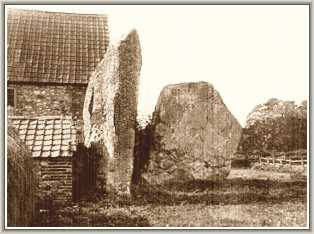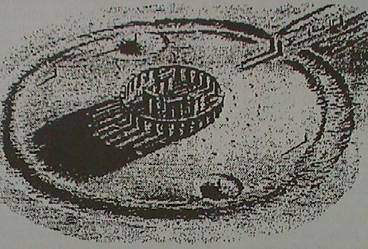|
 Henges:
(Form and Function)
Henges:
(Form and Function)
There are around 100 Henges in the British Isles, dating from 3,200 BC.
(1)
Henges are
prehistoric British constructions, generally consisting of a round
flattened area surrounded by a boundary earthwork, usually consisting
of a bank and/or a ditch. Although they are concentrated in Britain,
it is suggested (2),
that they are a local variations on other causewayed-enclosures and
defensive ramparts found at other sites in Europe (such as the Rondel
enclosures' of Bavaria's Isar Valley). In response to this, it is
noted that the arrangement of banks and ditches at British Henges is
such that they offer little, if no protection, and there is a clear
association with Grooved ware products, something which has not been
found on the continental mainland.
The banks and ditches around Henges
were often built on a massive scale. The ditch at Avebury, for example, is
9m deep and over 20m wide in places, while that at Durrington Walls is 6m
deep and 16m wide, with a 3m high bank.
A Henge is simply defined
as... 'A circular earthen bank and ditch
enclosing an area of varying diameter'
.(3)
The earth used to build the banks was taken from the
ditches and the central area flattened (Except for the Ring O'
Bookan on the Orkneys, which is suggested to have once contained a
mound similar to the nearby Maes Howe).
Henges are only known to occur in Britain
and Northern Ireland. They are commonly found in 'groups', each separated
by hundreds of miles. Most Henges never originally contained stone-circles.
(1)
The Classification of Henges -
Burl
(1), classifies them in the following
fashion:
| Class |
Feature |
Distribution |
| I and II |
Single
internal ditch. |
Widespread in Britain |
| IA and IIA |
Two ditches |
Eastern
England |
| IB and IIB |
Single
external ditch |
Very rare |
| IC and IIC |
No ditch |
Western
Britain |
...but adds that 'There was no national blueprint for
the design of a Henge'
Associated
Structures:
 Coves
are a group of three to five stones that form an squared enclosure
within stone circles and Henge.
An opening between the stones, oriented south east is also a feature. Coves
are a group of three to five stones that form an squared enclosure
within stone circles and Henge.
An opening between the stones, oriented south east is also a feature.
The Avebury cove
(Photo: Right), is recorded to have once had a third stone which
completed the cove and faced the existing slender "male" stone. This
fell in 1713 and was destroyed, just before Stuckley's drawing in
1720.
Other examples
include the following: Stanton Drew, Mount Pleasant, Callanish, Arbor Low
and Stennes below.

The Cove in the
Stennes stone circle, Orkneys is
controversially orientated towards Maes
Howe.
|
Henge facts:

The Henge at Avebury was originally 17m (55ft) high
from ditch bottom to bank top with a perimeter of over 1km.
|
|
What was the Function of a Henge? |
One of the most noticeable design features of
Henges is that the banks and ditches are not complimentary in terms of
defensive structures (as the ditch is generally on the inside). This
has led several people to suggest that they served 'Ritual' purposes,
although this by no means pinpoints their exact nature.
Burl is of the opinion that they were meeting places. He said of
them 'The width of the henge entrances argues against their
orientation being for astronomical observation unless there had been
a sighting post or stone outside them'. and adds that 'such sighting
posts need not be for solar or lunar use. Instead they could have
directed the eye towards hills or mountains of special importance to
the builders'.
(1)
There is little doubt that they served a ritualistic
purpose. The gravel banks of the three Henges at
Thornborough were all coated with
crystals of gypsum, rendering them white against the background.
(1)
The Orientation of
Henges:
The outlying portal stones/posts found at such sites as
Priddy, Mayburgh, Maumberry, Milfield N, Yeavering, Woodhenge and
Stonehenge
are all evidence of specific orientation of the Henges. At Stonehenge we
know that the four original sarsens (of which only the 'heel-stone'
remains), were originally placed to mark events on the lunar cycle.
Astronomy: It has long been suspected that
Henges may have been constructed in order to create an artificial horizon
line. The idea is compelling but there are objections to the theory as an
absolute. At Arbor low for example, the Henge is built on a slope, and the
height of the Henge is constant, following the slope of the hill, giving it
no practical astronomical potential. At Avebury, even the largest Henge in the
world cant hide the surrounding hills, and folds in the countryside, which
likewise make the building of a Henge for astronomical purposes unlikely, to
say the least.
There is a tendency for
Henges with a single entrance to have that entrance set in the north or
north-east while sites with two entrances are aligned SE-SSE to NW-NNW or
ENE-E to WSW-W.
Henges and Cursus:
It is now recognised that the
Henge at
Stonehenge and the three at
Thornborough were built at locations which had
Cursus at them before the Henges were built. This fact
suggests that the Henge design was 'successors' to Cursus in some
respect. The most immediately noticeable difference between the two
structures is that one is round while the other is elongated. Apart
from that, the two share several similarities, not least their being
superimposed over each other, (suggesting that the location itself
was likely of importance), as well as this, both monuments share a
flattened central area surrounded by a bank and/or ditch.
The Stonehenge Cursus has recently dated at 3,500 BC by a
team from Manchester University and is therefore older than the Henge.
(7) It is orientated towards the structure
known as Woodhenge.

There is
another Henge in England which shares its dimensions with the
original Stonehenge bank and ditch (Henge), called the 'Dorchester
Big-rings'. In addition to being the same circumference (of
366 MY) (4),
it lies on the St. Michael's leyline, and was also built over a
pre-existing Cursus monument. The Thornborough Henges, which
were also built over a Cursus all have the same circumference of
722 MY (2 x 366 MY) (4)
(More about Cursus)
|
When were the first Henges Constructed? |
The earliest Henges were built as early as 3,200 BC (Llandegai
North)
(1),
but the majority were made between 2,700 and 2,000 BC.
Arbour Low Henge-circle, England.
|
A List and Description of Henges: |
English Henges:
 Avebury,
England.
- The largest Henge in the World. Banks and ditch originally measuring over 15m
from bottom to top (right). Part of a larger connected, ritual landscape.
Has two avenues leading from it; the Beckhampton and West-Kennet. Avebury,
England.
- The largest Henge in the World. Banks and ditch originally measuring over 15m
from bottom to top (right). Part of a larger connected, ritual landscape.
Has two avenues leading from it; the Beckhampton and West-Kennet.
Dorchester Big
Rings, England - This Henge has the same circumference as
Stonehenge (366 MY)
(4), It lies on the St. Michael's
Leyline, and was built over a Cursus monument, as were Thornborough and
Stonehenge.
Gorsey Bigbury -
The 'portal' posts at Gorsey-Bigbury were held in place with pieces of red
sandstone, which is not a local stone, evidence of the selectivity of
stone at an early stage of megalithic constructing. An interest in
colours, textures and minerals on the part of prehistoric people has been
noticed at other Henges, including Stonehenge.
(1)
It is interesting that
the original 'Grooved-ware' builders of the Henge deserted it after just a
few years, following which it was occupied by the 'Beaker people' for
about 200-300 years. (1)
Knowlton Henge -
The last remaining of an original three Henges, the Knowlton complex is
now realised to have been re-used as a part of the sacred Dorset landscape
for thousands of years, ending with the Norman conversion in the 12th
century when a church was built in the central Henge.
Maumberry rings, England - Where forty-five
pits were sunk alongside each other, each one 10 metres deep and with
steps cut down the sides for access, and from which 50 tons of chalk was
removed from each. (1)
Priddy Henges - Another Triple
Henge
complex.
 Stonehenge
- The
Henge was the first structure built at c. 3,200 BC. The nearby
Cursus has been recently dated at c. 3,500 BC. It is said that
during the first phase of activity 'The sun apparently
didn't interest the builders'.
(1) The Henge has a circumference of
366 MY
(4), and the site is located on the
exact latitude such that the Sun and the Moon pass overhead at 90�
relative to each other on their maximum settings.
Thornborough - The
Thornborough complex consists of three vast Henges aligned to Orion, and
connected together by a 'ceremonial' path. The Henges were built over an
earlier Cursus. The circumferences of the Henges is 722 MY (2 x 366).
Waulud's Bank
- This partially destroyed Henge feature lies on the St. Michael's
Leyline, near the Icknield Way, and encloses five springs which make
up the source of the River Lea.
German Henges:
Goseck, Germany
- Recently restored Henge on the same latitude as Stonehenge. Dated at
5,000 BC.
Irish Henges:
Castelruddery, Ireland. -
This small Irish circle has two 15-ton recumbent, quartz, portal stones.
Lismullen Henge, Ireland
- Recently destroyed along with 41 other archaeological
sites in the Tara Skreen Valley, Ireland by the development of a double
tolled motorway through Irelands most sacred landscape?
(Click here for
more about the
desecration of the Lismullen henge and the Tara Valley)
Monknewton, Ireland
-
2,350 BC (1)
Scottish Henges:
Balfarg, Scotland. - Carbon
dated at 2,900 BC.
(1)
Stones of Stennes
- Scottish Henge on the Orkneys, estimated 12,500 man-hours labour
(1)
Welsh Henges:
Bryn-Celli-Ddu, Wales.
- Wales. The original Henge structure was later converted into a passage mound.
Bryn-Gwyn, Wales. - Welsh Henge.
Llandegai North (Wales) -
With dates of 3,200 BC from ditch material and 3,350 BC from a
cremation outside the west entrance, this may have been the first henge
ever erected. (1)
Danish Henges:
Trelleborg
- A Danish Henge on the island of Zealand, sited at the confluence of two
rivers. This Henge has produced several Neolithic 'ritual objects' such as
polished axe heads, including one of Bluestone (The same stone used at
Stonehenge)
(2).
(Return to Top)
|
 Coves
are a group of three to five stones that form an squared enclosure
within stone circles and Henge.
An opening between the stones, oriented south east is also a feature.
Coves
are a group of three to five stones that form an squared enclosure
within stone circles and Henge.
An opening between the stones, oriented south east is also a feature.



